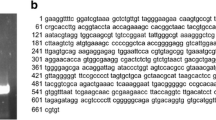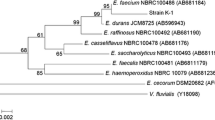Summary
Fermentation of cassava tubers was accompanied by a gradual decrease in pH, increased amylase activity in the steep liquor, and increased microbial load and lactic acid concentration. Amylase-producing bacterial strains associated with cassava fermentation were isolated and identified asBacillus subtilis, Bacillus licheniformis andBacillus cereus. The pH optima for the partially purified enzymes of these organisms were 7.0, 5.5 and 7.5, whilst their temperature optima were 30, 37 and 80°C. There was no significant difference in amylase activities when starch, dextrin, amylopectin, glucose and maltose were used as growth substrates.
Similar content being viewed by others
References
Akinrele, I.A. 1964. Fermentation of cassava. J. Sci. Food Agric. 15: 589–594.
Buchanan, R.E. and N.E. Gibbons. 1974. Bergey's Manual of Determinative Bacteriology, pp. 529–550, The Williams and Wilkins Company, Baltimore.
Campbell, L.L. 1955. Purification and properties of an α-amylase from facultative thermophilic bacteria. Arch. Biochem. Biophys. 54: 154–161.
Collard, P. and S.S. Levi. 1959. A two-stage fermentation of cassava. Nature (Lond.) 183: 620–621.
Cowan, S.T. 1974. Cowan and Steel's Manual for the Identification of Medical Bacteria, pp. 70–71, Cambridge University Press.
Lowry, O. H., N.J. Rosebrough, A.L. Farr and R.J. Randall. 1951. Protein measurement with the Folin phenol reagent. J. Biol. Chem. 193: 265–275.
Miller, G.L. 1959. Use of dinitrosalicylic acid reagent for determination of reducing sugar. Anal. Chem. 31: 426–428.
Morgan, F.J. and F.G. Priest. 1981. Characterization of a thermostable α-amylase fromBacillus licheniformis NCIB 6346. J. Appl. Bacteriol. 50: 107–114.
Nwachukwu, S.U. 1982. Modes and successions of yasts during the fermentation of some Nigerian foods and beverages. M.Sc. Thesis University of Lagos, Nigeria.
Okafor, N. 1977. Microorganisms associated with cassava fermentation for Gari production. J. Appl. Bacteriol. 42: 279–284.
Stark, E. and P.A. Tetrault. 1951. Isolation of cell-free starch saccharifying enzymes from the medium at 70°C. J. Bacteriol. 62: 247–252.
Author information
Authors and Affiliations
Rights and permissions
About this article
Cite this article
Amund, O.O., Ogunsina, O.A. Extracellular amylase production by cassava-fermenting bacteria. Journal of Industrial Microbiology 2, 123–127 (1987). https://doi.org/10.1007/BF01569511
Received:
Revised:
Accepted:
Issue Date:
DOI: https://doi.org/10.1007/BF01569511




